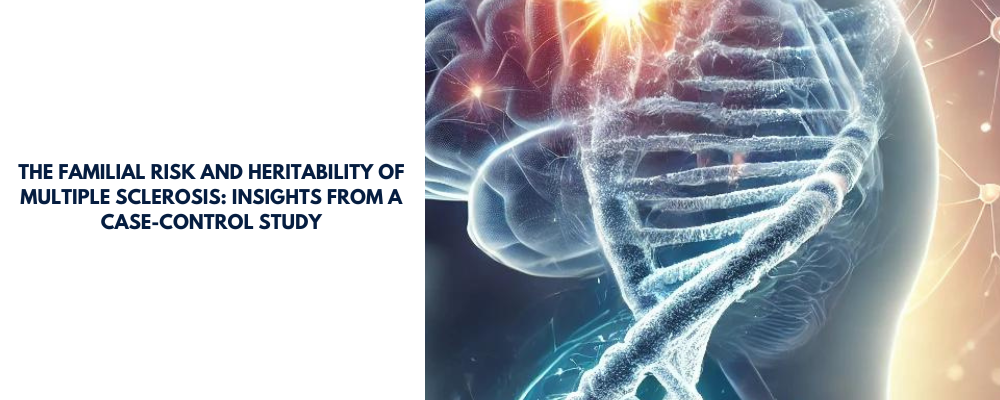The Familial Risk and Heritability of Multiple Sclerosis: Insights from a Case-Control Study

Multiple Sclerosis (MS) is a complex, immune-mediated neurodegenerative disease characterized by inflammation and degeneration of the central nervous system. While environmental factors play a crucial role in disease onset, genetic predisposition remains a significant component of MS risk. Recent studies have identified over 230 genetic variants linked to increased susceptibility to MS, highlighting the multifaceted nature of the disease. Understanding how these genetic and environmental factors interact, particularly in familial cases of MS, can provide valuable insights into the mechanisms of disease onset and progression.
A study conducted by Boles et al. (2023) aimed to evaluate the familial risk and heritability of MS and its primary phenotypes—Primary Progressive MS (PPMS) and Relapsing Onset MS (ROMS). Using a case-control design, the researchers analyzed data from over 25,000 MS patients of Nordic ancestry from the Swedish MS Registry, comparing them to more than 250,000 population-based controls. By investigating familial aggregation and genetic liability, they provided a detailed analysis of heritable components within these MS phenotypes.
Study Population and Methodology
The study included 25,186 MS patients with known phenotypes (1,593 PPMS and 16,718 ROMS cases). Familial risk and heritability were assessed using logistic regression models and threshold-liability models, focusing on first- and second-degree relatives of MS patients. The researchers used data from various Swedish national registries, including the Swedish MS Registry (SMSreg), the National Patient Register (NPR), and the Multi-Generational Register (MGR), to ensure comprehensive analysis across multiple generations.
This large population-based study was designed to explore familial clustering and genetic liability by examining the odds ratios (ORs) of MS diagnosis in family members of MS patients. First-degree relatives included parents, offspring, and full siblings, while second-degree relatives comprised grandparents, aunts/uncles, nieces/nephews, and half-siblings. This study design enabled the researchers to estimate the heritability of both MS onset and phenotypes, accounting for environmental and genetic influences.
Key Findings
Familial Risk in MS
The results revealed a significant increase in familial risk among both first- and second-degree relatives of MS patients, with higher risks observed in first-degree relatives. The OR for first-degree relatives of ROMS patients was 7.00, while for PPMS it was 8.06, indicating a slightly higher familial risk in PPMS compared to ROMS. Interestingly, second-degree relatives exhibited much lower ORs (2.16 for ROMS and 2.18 for PPMS), reflecting the expected reduction in genetic sharing in more distant family members.
Whole siblings had the highest risk, with an OR of 8.65 in ROMS and 9.51 in PPMS. These findings suggest that the familial risk for MS is substantial and comparable between the two phenotypes. Additionally, there were overlapping confidence intervals between PPMS and ROMS, indicating that there were no significant differences in familial risk between these phenotypes, a result that could suggest a shared etiology between the two forms of the disease.
Heritability Estimates
Heritability, which reflects the proportion of disease risk attributable to genetic factors, was calculated for MS, ROMS, and PPMS. The heritability of overall MS was estimated to be 51%, with ROMS at 55% and PPMS significantly lower at 23%. These findings support the idea that genetic factors play a significant role in MS, especially in relapsing forms of the disease. However, the lower heritability observed in PPMS suggests that environmental factors or non-additive genetic effects may have a more prominent role in this phenotype.
The heritability of MS onset age was also estimated using sibling pairs, with an overall heritability of 21.9%. This suggests that while genetic factors influence the age of disease onset, they account for a smaller portion of the variation compared to the overall risk of developing MS.
Implications for Clinical Practice and Research
The study’s findings have important implications for understanding the genetic and environmental underpinnings of MS. The similar familial risks observed between PPMS and ROMS suggest that both phenotypes may share common genetic risk factors, although the clinical presentations of the two forms differ. These results may help inform genetic counseling for families with a history of MS, as well as guide future research on the genetic mechanisms driving MS progression.
Additionally, the lower heritability observed in PPMS compared to ROMS underscores the need for further investigation into environmental risk factors and gene-environment interactions in PPMS. As PPMS is characterized by a more aggressive disease course and poorer response to disease-modifying treatments, understanding its distinct genetic and environmental triggers is critical for developing more effective therapies.
Limitations and Future Directions
While this study benefits from a large, well-characterized cohort, certain limitations should be noted. The smaller sample size of PPMS cases compared to ROMS may have contributed to wider confidence intervals in the heritability estimates for PPMS. Additionally, the study relied on registry-based diagnosis, which may be subject to misclassification bias, particularly in distinguishing between PPMS and ROMS. Future studies incorporating more refined diagnostic criteria and exploring other genetic models, such as gene-gene and gene-environment interactions, could provide further insights into the etiology of MS phenotypes.
Conclusion
Boles et al. (2023) provide robust evidence that familial risk is a significant factor in the development of MS, with no major differences in genetic liability between the two main MS phenotypes, ROMS and PPMS. The study highlights the importance of genetic factors in MS susceptibility and calls for continued research into the environmental and genetic contributors to different MS phenotypes. As our understanding of MS genetics evolves, so too will our ability to predict disease risk and develop targeted interventions for those at greatest risk.
Reference:
Boles, G. S., Hillert, J., Ramanujam, R., Westerlind, H., Olsson, T., Kockum, I., & Manouchehrinia, A. (2023). The familial risk and heritability of multiple sclerosis and its onset phenotypes: A case–control study. Multiple Sclerosis Journal, 29(10), 1209-1215.
